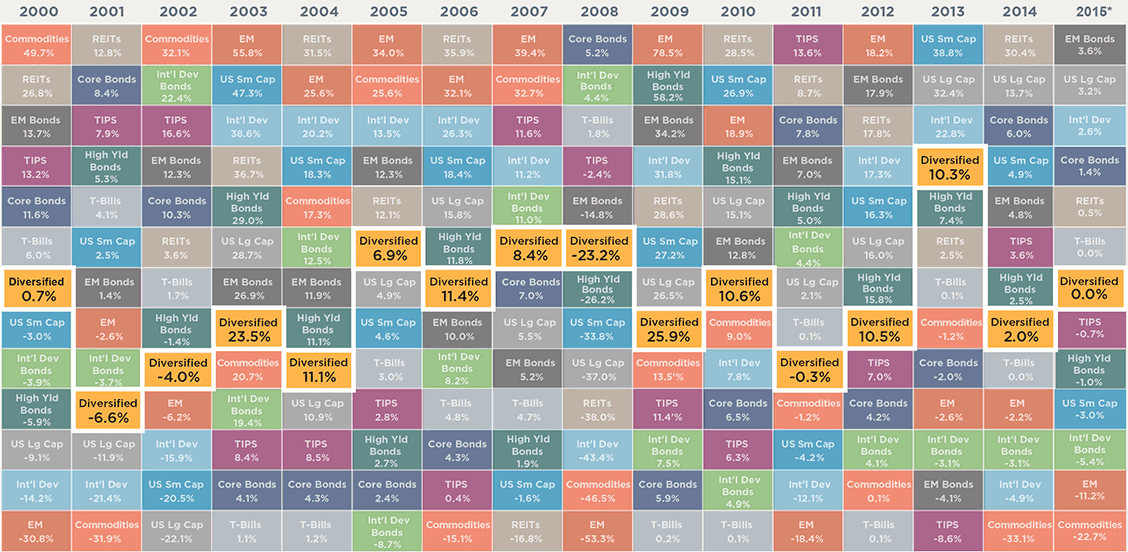Is Your Portfolio Really Diversified?
Your investments should be spread across a variety of stocks and bonds and cover a range of asset managers, asset classes and geographical locations.

Diversification is simple to understand. In the context of managing your portfolio, it is (simply) about investing in diverse securities so as to lower the risk of the portfolio. Ever since Nobel Prize winner Harry Markowitz wrote his seminal paper "Portfolio Selection" in 1952, finance professionals (and increasingly lay people) have understood that the true risk of an asset is its contribution to the risk of a portfolio.
In a recent survey run by my firm, Insight Financial Strategists, 41% of investors reported that they believe having their net worth in a single mutual fund is sufficient diversification. After all, even the most concentrated mutual fund typically has several dozen stocks. However, many mutual funds diversify within a single asset class in a single country, such as, large-company stocks in the U.S.
Others will concentrate their portfolio on a few securities, sometimes with very unfortunate results. For instance, between September 1, 2015, until November 17, 2015, the Sequoia fund (symbol SEQUX) lost 26.3% of its value largely due to its high concentration in a single stock, Valeant (VRX). Looking at the price evolution of VRX below, and knowing that SEQUX had more than 30% invested in VRX, it is not surprising that the mutual fund tumbled.
From just $107.88 $24.99 for Kiplinger Personal Finance
Become a smarter, better informed investor. Subscribe from just $107.88 $24.99, plus get up to 4 Special Issues

Sign up for Kiplinger’s Free Newsletters
Profit and prosper with the best of expert advice on investing, taxes, retirement, personal finance and more - straight to your e-mail.
Profit and prosper with the best of expert advice - straight to your e-mail.

In practice, diversification is hard to implement. There are many levels of diversification. Some of them are:
- by individual securities;
- by asset manager;
- by asset class; and
- by geography.
Ideally, an investor will want to diversify so that the various investments are not correlated with one another, have low correlation or even have negative correlation. For instance, according to data from portfolio analytics firm Kwanti, Goldman Sachs (GS) and JP Morgan (JPM) have an 89% correlation based on monthly returns. In other words, buying GS and JPM in the same portfolio only provides a low diversification value.
In another example, JPM and Walmart (WMT) have a negative correlation of -0.14%, based on monthly returns, according to data from Kwanti. I don't know that I would necessarily want to buy either JPM or WMT. However, this pair provides good diversification from one another.
Most of us end up investing in mutual funds and exchange-traded funds, not in individual securities. The same principle applies there. Having a single large cap mutual fund that tracks Standard & Poor's 500-stock index may not be sufficient diversification.
Sure, the S&P 500 ETF provides more than one security and is, therefore, diversified. But in general, most of the securities within a single asset class will be highly correlated with one another (such as with JPM and GS). With that, you would be protecting yourself against the risk inherent in any given company in the portfolio, but not against risks inherent to the asset class or other factors.
Ideally, you would want to be diversified across asset classes, across regions of the world and across asset managers. The following jelly bean chart from Schwab demonstrates the benefits of a wide diversification program: the ranking of the assets by performance changes seemingly randomly from year to year. A fully diversified portfolio is intended to avoid the peaks and valleys of individuals asset classes while providing a more middle-of-the-road return experience.

Is your portfolio diversified? A detailed analysis from a fee-only Certified Financial Planner can give you the full scoop on your portfolio and provide suggestions to mitigate the risks that you are exposed to. Like any other sound advice, apply it now, not later.
Chris Chen CFP® CDFA is the founder of Insight Financial Strategists LLC, a fee-only investment advisory firm in Waltham, MA. He specializes in retirement planning and divorce financial planning for professionals and business owners.
Profit and prosper with the best of Kiplinger's advice on investing, taxes, retirement, personal finance and much more. Delivered daily. Enter your email in the box and click Sign Me Up.

Chris Chen CFP® CDFA is the founder of Insight Financial Strategists LLC, a fee-only investment advisory firm in Newton, Mass. He specializes in retirement planning and divorce financial planning for professionals and business owners. Chris is a member of the National Association of Personal Financial Advisors (NAPFA). He is on the Board of Directors of the Massachusetts Council on Family Mediation.
-
 10 Cheapest Places to Live in Washington
10 Cheapest Places to Live in WashingtonProperty Tax Is Washington your go-to ski destination? These counties combine no income tax with the lowest property tax bills in the state.
-
 Healthy to 100: Secrets from Countries Where Retirees Age Best
Healthy to 100: Secrets from Countries Where Retirees Age BestLongevity is a team sport, according to author Ken Stern. Here's the secret sauce for living long, healthy lives from countries like Italy and Japan.
-
 My First $1 Million: Semiretired CPA, 68, San Francisco
My First $1 Million: Semiretired CPA, 68, San FranciscoEver wonder how someone who's made a million dollars or more did it? Kiplinger's My First $1 Million series uncovers the answers.
-
 6 Overlooked Areas That Can Make or Break Your Retirement, From a Retirement Adviser
6 Overlooked Areas That Can Make or Break Your Retirement, From a Retirement AdviserIf you're heading into retirement with scattered and uncertain plans, distilling them into these six areas can ensure you thrive in later life.
-
 I'm a Wealth Adviser: These Are the 7 Risks Your Retirement Plan Should Address
I'm a Wealth Adviser: These Are the 7 Risks Your Retirement Plan Should AddressYour retirement needs to be able to withstand several major threats, including inflation, longevity, long-term care costs, market swings and more.
-
 High-Net-Worth Retirees: Don't Overlook These Benefits of Social Security
High-Net-Worth Retirees: Don't Overlook These Benefits of Social SecurityWealthy retirees often overlook Social Security. But timed properly, it can drive tax efficiency, keep Medicare costs in check and strengthen your legacy.
-
 Do You Have an Insurance Coverage Gap for Your Valuables? You May Be Surprised to Learn You Do
Do You Have an Insurance Coverage Gap for Your Valuables? You May Be Surprised to Learn You DoStandard homeowners insurance usually has strict limits on high-value items, so you should formally "schedule" these valuable possessions with your insurer.
-
 8 Practical Ways to Declutter Your Life in 2026: A Retirement 'Non-Resolution' Checklist
8 Practical Ways to Declutter Your Life in 2026: A Retirement 'Non-Resolution' ChecklistHere's how to stop wasting your energy on things that don't enhance your new chapter and focus on the things that do.
-
 To Retire Rich, Stop Chasing Huge Returns and Do This Instead, Courtesy of a Financial Planner
To Retire Rich, Stop Chasing Huge Returns and Do This Instead, Courtesy of a Financial PlannerSaving a large percentage of your income, minimizing taxes and keeping spending in check can offer a more realistic path to retiring rich.
-
 New Year, New Retirement Rules: Here's How You Can Keep Up as the Landscape Changes
New Year, New Retirement Rules: Here's How You Can Keep Up as the Landscape ChangesFor a successful modern retirement, prepare for a longer life, manage high health care costs and prioritize your social life and purpose.
-
 7 Creative Ways to Spend Less and Save More In Retirement, Courtesy of a Financial Pro
7 Creative Ways to Spend Less and Save More In Retirement, Courtesy of a Financial ProWorried you won't have enough money later in life? Try redesigning your vision of retirement, and you may find your savings go further than you thought.